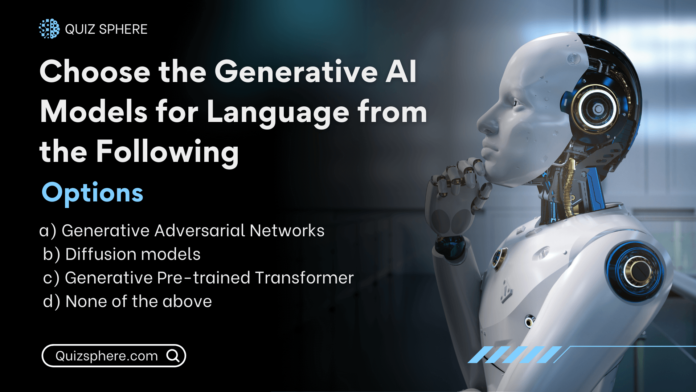Quiz: Choose the Generative Al models for language from the following
Options:

a) Generative Adversarial Networks
b) Diffusion models
c) Generative Pre-trained Transformer
d) None of the above
Quiz Sphere Homework Help: Questions and Answers: Choose the Generative AI Models for Language from the Following
Correct Answer: c) Generative Pre-trained Transformer (GPT)
The answer to this question is c) GPT since it is created especially for language understanding and generation. This model is able to create articulate and contextually accurate pieces of text based on the given prompt due to the transforming structure, which makes it superb at managing sequential data.
Now, let us analyze the rest of the choices and how each compare against the reasons why GPT is most preferred for generating tasks.
A) Generative Adversarial Networks (GANs)
What are they? Generative Adversarial Networks, or GANs, is a tried-and-tested machine learning method consisting of two neural networks, the generator and the discriminator, which work against each other. The generator tries to create data that looks real, whereas the discriminator tries to test whether the data produced is real or fake. This opposition struggle makes it easy for GANs to generate simulated data that is considered high quality.
Applications of Gan Are:
- Image Synthesis: GANs have a large role in synthesizing realistic photographs, for example, face data synthesis with deepfake technology
- Art and Creativity: Tools such as Artbreeder, which create stunning art images make use of GANs.
- Video Generation: GANs can create videos with realistic movements and sequences.
Why GANs do not work for language generation: GANs perform tremendously when it comes to structured data creation, such as images and videos, but they falter in our language due to the sequential and distinct character of words. A language model is required to accurately preserve context, maintain coherence, and uphold grammar, none of which GANs are built to do. GANs face challenges in complex linguistic rule structures, which makes them impossible to use for essay, dialogue, and other natural speech generation.
b) Diffusion Models
What are Diffusion Models? Diffusion models are a subset of generative AI models that utilize refined sequences of noise to create a coherent output. These models are trained to reproduce the results of a slow and overrated noise adding process to produce more detailed and styled data. They have gained a lot of traction lately, especially with producing images of exceptional quality
Applications of Diffusion Models:
- Image Generation: The DALL·E 2 or Stable Diffusion tools, which rely on these models, can now create amazing artefacts via text prompts.
- Denoising Tasks: Noise removal from images and rebuilding of distressed visual data fall under the responsibilities of Diffusion models.
- Scientific Simulations: They are used in regions of science, for example, physics to simulate intricate systems.
Why Diffusion Models are not suitable for language generation: The formation of language contains dependencies to various phrases and context for usage of the previous statements created.
Diffusion models are not meant for these tasks as their strength lies in the refinement of global structures – for instance, images – rather than in maintaining the complex relationships of sequential data like text. So, they are ineffective when it comes to generative language activities.
c) GPT – Generative Pre-trained Transformer
What is GPT? Generative Pre-trained Transformer, or GPT, is one of the best NLP models AI has to offer, developed by openai. It adopts the transformer architecture with self-attention mechanisms used to process and produce text as a base. GPT models come with a pre-trained setup. They are prepared with a lot of text data and do not need much training after that. Instead, they are tuned for particular uses which makes them incredibly flexible.
Key Features of GPT:
- Transformer Architecture: GPT uses transformers to capture the context of words used within a sentence and provide relevant answers.
- Pre-training and Fine-tuning: GPT’s base are on understanding a large language model because it has access to endless documents and can be fine-tuned for specific needs.
- Scalability: Models such as GPT-3 and GPT-4 showed that the more parameters set to a model, the better its language understanding and generation will be.
Why GPT is the correct answer: GPT was made specifically for generative language tasks.
It’s the ideal option for tasks like: chatbots and conversational AI, summarization, language translation and content generation. It’s a proficient option for these tasks because it can model long term dependencies of a given text and also generate appropriate contextual content.
GPT differs from other models like diffusion and GANs because it is specially trained to understand complex grammatical constructs of language and generate appropriate responses. Because of this, it is the best optimal choice for completing generative tasks with language.
d) None of the Above
This option is incorrect because GPT optioned in c is most persuasive and optioned as a generative model for natural language processes. The existence of this option shows why one must know the different generative models available.
Conclusion
From the provided options, it is c) Generative Pre-trained Transformer (GPT) is the answer to the query concerning generative language models. Its transformer-based architecture and broad pre-training, coupled with extensive fine-tuning of the model, makes GPT uniquely suited for almost all-natural language processing tasks. While the image creation tasks would be mammoths for GANs and diffusion models, they would struggle to complete a sentence due to a lack of order and context comprehension in a sequential form.
Understanding these differences will determine how best an AI model will fit specific needs. Models like GPT will always be ahead in the race to capture moments of AI speech because of the endless possibilities of advancement this model brings across different fields.



